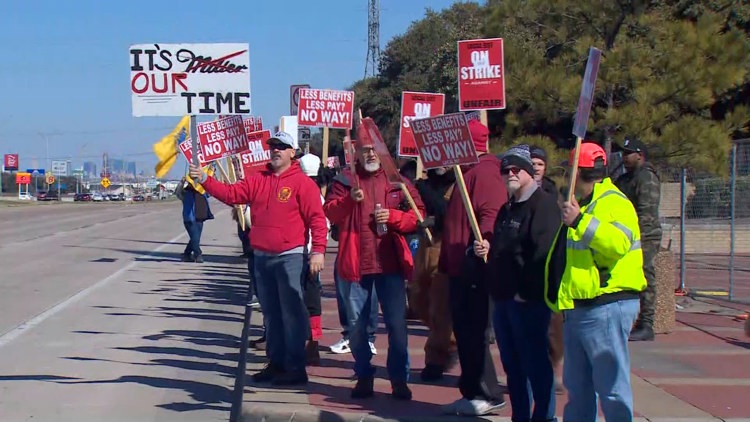TEXAS, USA — Unions in Texas have made headlines this year – from Dallas Black Dance Theatre dancers who allege they were fired after they formed a union to strikes by union members at Molson Coors and American Airlines.
Here’s what to know about how unions are formed, laws regarding unions nationally and in Texas and how Texas stacks up against the rest of the country in terms of union membership and unfair labor practice complaints.
How is a union formed?
There are two ways to certify a union. One is through voluntary recognition. The steps include contacting a union organizer or starting a union, having a majority of coworkers sign union authorization cards, and asking your employer for voluntary recognition. If the employer recognizes the union, you can begin bargaining. If the employer refuses to recognize the union, you can file a petition for an election with the National Labor Relations Board.
For NLRB recognition, at least 30% of coworkers are required to sign union authorization cards before a petition for election can be filed with the NLRB. If the union wins 50% plus one of the votes cast, the employer is required to begin bargaining.
Right to work laws and Texas
Texas is among 26 states that have adopted right-to-work laws. Texas’ law was adopted in 1993.
Right to work laws allow workers in unionized workplaces to opt out of paying union dues and the right to work in a unionized workplace without being part of the union. The Texas Republican Party’s 2024 platform includes support for passing a national Right to Work law.
"Essentially, right to work means the right to work without having to join a union. Employees in right to work states can still voluntarily join unions and they still have protections from employers’ unfair labor practices enforced by the National Labor Relations Board,” said Texas A&M University School of Law professor Michael Green. “The union has a duty to represent all employees in a bargaining unit including employees who choose not to join the union and don’t have to pay union dues. While a hindrance for labor unions in that it is expensive to represent employees, especially those who don’t pay union dues to help fortify the union’s representation expenses, it does not mean you cannot have a union in a right to work state.”
Green said if employees can file an unfair labor practice claim with the National Labor Relations Board if an employer “interferes with, restrains, or coerces employees in the exercise of those rights.”
“That federal agency can then take action seeking to protect those employees from the employers’ actions,” said Green.
Where does Texas stand in terms of union membership?
Texas had 586,000 union members in 2023, up from 518,000 in 2022, according to the U.S. Bureau of Labor Statistics.
Specifically, about 4.5% of the workforce in Texas belonged to a union in 2023, up from 4.1% in 2022, data shows.
While the number of Texans who are union members is ticking up, Texas still lags behind the national rate significantly.
Nationally, about 10% of the workforce belonged to unions in 2023, largely unchanged from 2022, but down compared to 2021, according to the U.S. Bureau of Labor Statistics.
The union membership rate for the state was at its peak in 1993, when it averaged 7.5%, and at its low point in 2021 at 3.8%, according to the U.S. Bureau of Labor Statistics.
Since 1989, when comparable state data became available, union membership rates in Texas have consistently been below the national average.
Rates of petitions to join unions up
The National Labor Relations Board said it received 3,286 union election petitions between Oct. 1, 2023 and Sept. 30, 2024, up 27% from fiscal year 2023, when the agency got 1,638 petitions.
Unfair labor practice charges are also on the rise.
From fiscal year 2023 to fiscal year 2024, unfair labor practice charge filings increased 7% (from 19,869 to 21,292 cases).
In Texas, there were 1,372 unfair labor practice cases in fiscal year 2024, a 14% increase from fiscal year 2023 when there were 1,200.
Unfair labor practice cases in Texas
Unfair labor practice cases nationally
“The surge in cases we’ve received in the last few years is a testament to workers knowing and exercising their rights under the National Labor Relations Act and to our board agents’ accessibility and respectful engagement with them,” said NLRB General Counsel Jennifer Abruzzo. “I urge Congress to fully fund the NLRB so that employers, unions, and workers receive prompt and meaningful case resolutions.”



